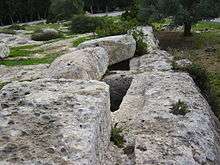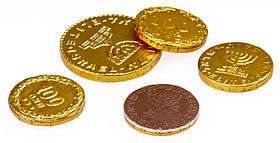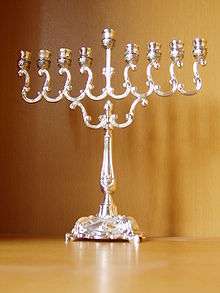Hanukkah
Hanukkah (/ˈhɑːnəkə/ HAH-nə-kə; Hebrew: חֲנֻכָּה ḥanuká, Tiberian: ḥanuká, usually spelled חֲנוּכָּה, pronounced [χanuˈka] in Modern Hebrew, [ˈχanukə] or [ˈχanikə] in Yiddish; a transliteration also romanized as Chanukah or Ḥanukah) is a Jewish festival commemorating the rededication of the Second Temple in Jerusalem at the time of the Maccabean Revolt against the Seleucid Empire. It is also known as the Festival of Lights (Hebrew: חַג הַאוּרִים, ḥag ha'urim).
| Hanukkah | |
|---|---|
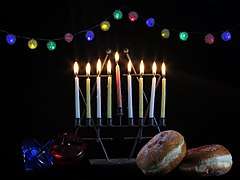 | |
| Official name | Hebrew: חֲנֻכָּה or חֲנוּכָּה English translation: "Establishing" or "Dedication" (of the Temple in Jerusalem) |
| Observed by | Jews |
| Type | Jewish |
| Significance | The Maccabees successfully rebelled against Antiochus IV Epiphanes. According to the Talmud, a late text, the Temple was purified and the wicks of the menorah miraculously burned for eight days, even though there was only enough sacred oil for one day's lighting. |
| Celebrations | Lighting candles each night. Singing special songs, such as Ma'oz Tzur. Reciting the Hallel prayer. Eating foods fried in oil, such as latkes and sufganiyot, and dairy foods. Playing the dreidel game, and giving Hanukkah gelt |
| Begins | 25 Kislev |
| Ends | 2 Tevet or 3 Tevet |
| Date | 25 Kislev, 26 Kislev, 27 Kislev, 28 Kislev, 29 Kislev, 30 Kislev, 1 Tevet, 2 Tevet, 3 Tevet |
| 2019 date | Sunset, 22 December – nightfall, 30 December[1] |
| 2020 date | Sunset, 10 December – nightfall, 18 December[1] |
| 2021 date | Sunset, 28 November – nightfall, 6 December[1] |
| 2022 date | Sunset, 18 December – nightfall, 26 December[1] |
| Related to | Purim, as a rabbinically decreed holiday. |
Hanukkah is observed for eight nights and days, starting on the 25th day of Kislev according to the Hebrew calendar, which may occur at any time from late November to late December in the Gregorian calendar. The festival is observed by lighting the candles of a candelabrum with nine branches, called a menorah (or hanukkiah). One branch is typically placed above or below the others and its candle is used to light the other eight candles. This unique candle is called the shamash (Hebrew: שַׁמָּשׁ, "attendant"). Each night, one additional candle is lit by the shamash until all eight candles are lit together on the final night of the festival.[2] Other Hanukkah festivities include playing the game of dreidel and eating oil-based foods, such as latkes and sufganiyot, and dairy foods. Since the 1970s, the worldwide Chabad Hasidic movement has initiated public menorah lightings in open public places in many countries.[3]
Although a relatively minor holiday in strictly religious terms, Hanukkah has attained major cultural significance in North America and elsewhere among secular Jews as a Jewish alternative to Christmas, and is often celebrated correspondingly fervently.[4]
Etymology
The name "Hanukkah" derives from the Hebrew verb "חנך", meaning "to dedicate". On Hanukkah, the Maccabean Jews regained control of Jerusalem and rededicated the Temple.[5][6] Many homiletical explanations have been given for the name:[7]
- The name can be broken down into חנו כ"ה, "[they] rested [on the] twenty-fifth", referring to the fact that the Jews ceased fighting on the 25th day of Kislev, the day on which the holiday begins.[8]
- חנוכה (Hanukkah) is also the Hebrew acronym for ח נרות והלכה כבית הלל – "Eight candles, and the halakha is like the House of Hillel". This is a reference to the disagreement between two rabbinical schools of thought – the House of Hillel and the House of Shammai – on the proper order in which to light the Hanukkah flames. Shammai opined that eight candles should be lit on the first night, seven on the second night, and so on down to one on the last night (because the miracle was greatest on the first day). Hillel argued in favor of starting with one candle and lighting an additional one every night, up to eight on the eighth night (because the miracle grew in greatness each day). Jewish law adopted the position of Hillel.[9]
Alternative spellings

In Hebrew, the word Hanukkah is written חֲנֻכָּה or חֲנוּכָּה (Ḥănukkāh). It is most commonly transliterated to English as Hanukkah or Chanukah. The former spelling (Hanukkah), which is based on using characters of the English alphabet as symbols to re-create the word's correct spelling in Hebrew,[10] is the most common[11] and the preferred choice of Merriam–Webster,[12] Collins English Dictionary, the Oxford Style Manual, and the style guides of The New York Times and The Guardian.[13] The sound represented by Ch ([χ], similar to the Scottish pronunciation of loch) is not native to the English language.[14] Furthermore, the letter ḥeth (ח), which is the first letter in the Hebrew spelling, is pronounced differently in modern Hebrew (voiceless uvular fricative) from in classical Hebrew (voiceless pharyngeal fricative [ħ]), and neither of those sounds is unambiguously representable in English spelling. However, its original sound is closer to the English H than to the Scottish Ch, and Hanukkah more accurately represents the spelling in the Hebrew alphabet.[10] Moreover, the 'kaf' consonant is geminate in classical (but not modern) Hebrew. Adapting the classical Hebrew pronunciation with the geminate and pharyngeal Ḥeth can lead to the spelling Hanukkah, while adapting the modern Hebrew pronunciation with no gemination and uvular Ḥeth leads to the spelling Chanukah.
Historical sources
Books of Maccabees
The story of Hanukkah is preserved in the books of the First and Second Maccabees, which describe in detail the re-dedication of the Temple in Jerusalem and the lighting of the menorah. These books are not part of the canonized Tanakh (Hebrew Bible) used by modern Jews, though the Catholic and Orthodox Churches consider them part of the Old Testament.[15]
The eight-day rededication of the temple is described in 1 Maccabees 4:36–4:59, though the name of the festival and the miracle of the lights do not appear here. A story similar in character, and older in date, is the one alluded to in 2 Maccabees 1:18–1:36 according to which the relighting of the altar fire by Nehemiah was due to a miracle which occurred on the 25th of Kislev, and which appears to be given as the reason for the selection of the same date for the rededication of the altar by Judah Maccabee. The above account in 1 Maccabees 4, as well as 2 Maccabees 1:9 portrays the feast as a delayed observation of the eight-day Feast of Booths (Sukkot)"; similarly 2 Maccabees 10:6 explains the length of the feast as "in the manner of the Feast of Booths".
Early rabbinic sources
Megillat Taanit (1st century) contains a list of festive days on which fasting or eulogizing is forbidden. It specifies, "On the 25th of [Kislev] is Hanukkah of eight days, and one is not to eulogize" but gives no further details.
The Mishna (late 2nd century) mentions Hanukkah in several places,[16] but never describes its laws in detail and never mentions any aspect of the history behind it. To explain the Mishna's lack of a systematic discussion of Hanukkah, Rav Nissim Gaon postulated that information on the holiday was so commonplace that the Mishna felt no need to explain it.[17] Modern scholar Reuvein Margolies suggests that as the Mishnah was redacted after the Bar Kochba revolt, its editors were reluctant to include explicit discussion of a holiday celebrating another relatively recent revolt against a foreign ruler, for fear of antagonizing the Romans.[18]
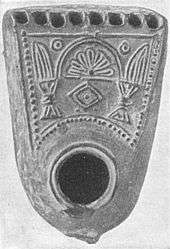
The miracle of the one-day supply of oil miraculously lasting eight days is first described in the Talmud, committed to writing about 600 years after the events described in the books of Maccabees.[19] The Talmud says that after the forces of Antiochus IV had been driven from the Temple, the Maccabees discovered that almost all of the ritual olive oil had been profaned. They found only a single container that was still sealed by the High Priest, with enough oil to keep the menorah in the Temple lit for a single day. They used this, yet it burned for eight days (the time it took to have new oil pressed and made ready).[20]
The Talmud presents three options:[21]
- The law requires only one light each night per household,
- A better practice is to light one light each night for each member of the household
- The most preferred practice is to vary the number of lights each night.
Except in times of danger, the lights were to be placed outside one's door, on the opposite side of the mezuza, or in the window closest to the street. Rashi, in a note to Shabbat 21b, says their purpose is to publicize the miracle. The blessings for Hanukkah lights are discussed in tractate Succah, p. 46a.[22]
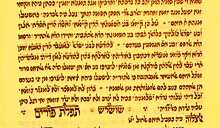
Megillat Antiochus (probably composed in the 2nd century[23]) concludes with the following words:
...After this, the sons of Israel went up to the Temple and rebuilt its gates and purified the Temple from the dead bodies and from the defilement. And they sought after pure olive oil to light the lamps therewith, but could not find any, except one bowl that was sealed with the signet ring of the High Priest from the days of Samuel the prophet and they knew that it was pure. There was in it [enough oil] to light [the lamps therewith] for one day, but the God of heaven whose name dwells there put therein his blessing and they were able to light from it eight days. Therefore, the sons of Ḥashmonai made this covenant and took upon themselves a solemn vow, they and the sons of Israel, all of them, to publish amongst the sons of Israel, [to the end] that they might observe these eight days of joy and honour, as the days of the feasts written in [the book of] the Law; [even] to light in them so as to make known to those who come after them that their God wrought for them salvation from heaven. In them, it is not permitted to mourn, neither to decree a fast [on those days], and anyone who has a vow to perform, let him perform it.[24]
The Al HaNissim prayer is recited on Hanukkah as an addition to the Amidah prayer, which was formalized in the late 1st century.[25] Al HaNissim describes the history of the holiday as follows:
- In the days of Mattiyahu ben Yohanan, high priest, the Hasmonean and his sons, when the evil Greek kingdom stood up against Your people Israel, to cause them to forget Your Torah and abandon the ways You desire – You, in Your great mercy, stood up for them in their time of trouble; You fought their fight, You judged their judgment, You took their revenge; You delivered the mighty into the hands of the weak, the many into the hands of the few, the impure into the hands of the pure, the evil into the hands of the righteous, the sinners into the hands of those who engaged in Your Torah; You made yourself a great and holy name in Your world, and for Your people Israel You made great redemption and salvation as this very day. And then Your sons came to the inner chamber of Your house, and cleared Your Temple, and purified Your sanctuary, and lit candles in Your holy courtyards, and established eight days of Hanukkah for thanksgiving and praise to Your holy name.
Narrative of Josephus
The Jewish historian Titus Flavius Josephus narrates in his book, Jewish Antiquities XII, how the victorious Judas Maccabeus ordered lavish yearly eight-day festivities after rededicating the Temple in Jerusalem that had been profaned by Antiochus IV Epiphanes.[26] Josephus does not say the festival was called Hanukkah but rather the "Festival of Lights":
- Now Judas celebrated the festival of the restoration of the sacrifices of the temple for eight days, and omitted no sort of pleasures thereon; but he feasted them upon very rich and splendid sacrifices; and he honored God, and delighted them by hymns and psalms. Nay, they were so very glad at the revival of their customs, when, after a long time of intermission, they unexpectedly had regained the freedom of their worship, that they made it a law for their posterity, that they should keep a festival, on account of the restoration of their temple worship, for eight days. And from that time to this we celebrate this festival, and call it Lights. I suppose the reason was because this liberty beyond our hopes appeared to us; and that thence was the name given to that festival. Judas also rebuilt the walls round about the city, and reared towers of great height against the incursions of enemies, and set guards therein. He also fortified the city Bethsura, that it might serve as a citadel against any distresses that might come from our enemies.[27]
Other ancient sources
In the New Testament, John 10:22–23 says, "Then came the Festival of Dedication at Jerusalem. It was winter, and Jesus was in the temple courts walking in Solomon’s Colonnade" (NIV). The Greek noun used appears in the neuter plural as "the renewals" or "the consecrations" (Greek: τὰ ἐγκαίνια; ta enkaínia).[28] The same root appears in 2 Esdras 6:16 in the Septuagint to refer specifically to Hanukkah. This Greek word was chosen because the Hebrew word for "consecration" or "dedication" is "Hanukkah" (חנכה). The Aramaic New Testament uses the Aramaic word "Khawdata" (a close synonym), which literally means "renewal" or "to make new." [29]
Story
Background
Judea was part of the Ptolemaic Kingdom of Egypt until 200 BCE when King Antiochus III the Great of Syria defeated King Ptolemy V Epiphanes of Egypt at the Battle of Panium. Judea then became part of the Seleucid Empire of Syria.[30] King Antiochus III the Great, wanting to conciliate his new Jewish subjects, guaranteed their right to "live according to their ancestral customs" and to continue to practice their religion in the Temple of Jerusalem.[31] However, in 175 BCE, Antiochus IV Epiphanes, the son of Antiochus III, invaded Judea, at the request of the sons of Tobias.[32] The Tobiads, who led the Hellenizing Jewish faction in Jerusalem, were expelled to Syria around 170 BCE when the high priest Onias and his pro-Egyptian faction wrested control from them. The exiled Tobiads lobbied Antiochus IV Epiphanes to recapture Jerusalem. As Flavius Josephus relates:
The king being thereto disposed beforehand, complied with them, and came upon the Jews with a great army, and took their city by force, and slew a great multitude of those that favored Ptolemy, and sent out his soldiers to plunder them without mercy. He also spoiled the temple, and put a stop to the constant practice of offering a daily sacrifice of expiation for three years and six months.
Traditional view
When the Second Temple in Jerusalem was looted and services stopped, Judaism was outlawed. In 167 BCE, Antiochus ordered an altar to Zeus erected in the Temple. He banned brit milah (circumcision) and ordered pigs to be sacrificed at the altar of the temple.[34]
Antiochus's actions provoked a large-scale revolt. Mattathias (Mattityahu), a Jewish priest, and his five sons Jochanan, Simeon, Eleazar, Jonathan, and Judah led a rebellion against Antiochus. It started with Mattathias killing first a Jew who wanted to comply with Antiochus's order to sacrifice to Zeus, and then a Greek official who was to enforce the government's behest (1 Mac. 2, 24–25[35]). Judah became known as Yehuda HaMakabi ("Judah the Hammer"). By 166 BCE Mattathias had died, and Judah took his place as leader. By 165 BCE the Jewish revolt against the Seleucid monarchy was successful. The Temple was liberated and rededicated. The festival of Hanukkah was instituted to celebrate this event.[36] Judah ordered the Temple to be cleansed, a new altar to be built in place of the polluted one and new holy vessels to be made. According to the Talmud, unadulterated and undefiled pure olive oil with the seal of the kohen gadol (high priest) was needed for the menorah in the Temple, which was required to burn throughout the night every night. The story goes that one flask was found with only enough oil to burn for one day, yet it burned for eight days, the time needed to prepare a fresh supply of kosher oil for the menorah. An eight-day festival was declared by the Jewish sages to commemorate this miracle.[37]
The version of the story in 1 Maccabees states that an eight-day celebration of songs and sacrifices was proclaimed upon re-dedication of the altar, and makes no specific mention of the miracle of the oil.[38]
Academic sources
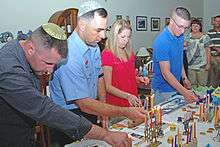
Some modern scholars argue that the king was intervening in an internal civil war between the Maccabean Jews and the Hellenized Jews in Jerusalem.[39][40][41][42] These competed violently over who would be the High Priest, with traditionalists with Hebrew/Aramaic names like Onias contesting with Hellenizing High Priests with Greek names like Jason and Menelaus.[43] In particular, Jason's Hellenistic reforms would prove to be a decisive factor leading to eventual conflict within the ranks of Judaism.[44] Other authors point to possible socioeconomic reasons in addition to the religious reasons behind the civil war.[45]
What began in many respects as a civil war escalated when the Hellenistic kingdom of Syria sided with the Hellenizing Jews in their conflict with the traditionalists.[46] As the conflict escalated, Antiochus took the side of the Hellenizers by prohibiting the religious practices the traditionalists had rallied around. This may explain why the king, in a total departure from Seleucid practice in all other places and times, banned a traditional religion.[47]
The miracle of the oil is widely regarded as a legend and its authenticity has been questioned since the Middle Ages.[48] However, given the famous question Rabbi Yosef Karo posed concerning why Hanukkah is celebrated for eight days when the miracle was only for seven days (since there was enough oil for one day),[49] it was clear that he believed it was a historical event. This belief has been adopted by most of Orthodox Judaism, in as much as Rabbi Karo's Shulchan Aruch is a main Code of Jewish Law.
Timeline
- 198 BCE: Armies of the Seleucid King Antiochus III (Antiochus the Great) oust Ptolemy V from Judea and Samaria.[30]
- 175 BCE: Antiochus IV (Epiphanes) ascends the Seleucid throne.[50]
- 168 BCE: Under the reign of Antiochus IV, the second Temple is looted, Jews are massacred, and Judaism is outlawed.[51]
- 167 BCE: Antiochus orders an altar to Zeus erected in the Temple. Mattathias and his five sons John, Simon, Eleazar, Jonathan, and Judah lead a rebellion against Antiochus. Judah becomes known as Judah Maccabee ("Judah the Hammer").
- 166 BCE: Mattathias dies, and Judah takes his place as leader. The Hasmonean Jewish Kingdom begins; It lasts until 63 BCE.
- 165 BCE: The Jewish revolt against the Seleucid monarchy is successful in recapturing the Temple, which is liberated and rededicated (Hanukkah).
- 142 BCE: Re-establishment of the Second Jewish Commonwealth. The Seleucids recognize Jewish autonomy. The Seleucid kings have a formal overlordship, which the Hasmoneans acknowledge. This inaugurates a period of population growth and religious, cultural and social development. This includes the conquest of the areas now covered by Transjordan, Samaria, Galilee, and Idumea (also known as Edom), and the forced conversion of Idumeans to the Jewish religion, including circumcision.[52]
- 139 BCE: The Roman Senate recognizes Jewish autonomy.[53]
- 134 BCE: Antiochus VII Sidetes besieges Jerusalem. The Jews under John Hyrcanus become Seleucid vassals but retain religious autonomy.[54]
- 129 BCE: Antiochus VII dies.[55] The Hasmonean Jewish Kingdom throws off Syrian rule completely.
- 96 BCE: Beginning of an eight-year civil war between Sadducee king Alexander Yanai and the Pharisees.[56]
- 85–82 BCE: Consolidation of the Kingdom in territory east of the Jordan River.[57]
- 63 BCE: The Hasmonean Jewish Kingdom comes to an end because of a rivalry between the brothers Aristobulus II and Hyrcanus II, both of whom appeal to the Roman Republic to intervene and settle the power struggle on their behalf. The Roman general Gnaeus Pompeius Magnus (Pompey the Great) is dispatched to the area. 12 thousand Jews are massacred in the Roman Siege of Jerusalem. The Priests of the Temple are struck down at the Altar. Rome annexes Judea.[58]
Battles of the Maccabean Revolt
Selected battles between the Maccabees and the Seleucid Syrian-Greeks:
- Battle of Adasa (Judas Maccabeus leads the Jews to victory against the forces of Nicanor.)
- Battle of Beth Horon (Judas Maccabeus defeats the forces of Seron.)
- Battle of Beth-zechariah (Elazar the Maccabee is killed in battle. Lysias has success in battle against the Maccabees, but allows them temporary freedom of worship.)
- Battle of Beth Zur (Judas Maccabeus defeats the army of Lysias, recapturing Jerusalem.)
- Dathema (A Jewish fortress saved by Judas Maccabeus.)
- Battle of Elasa (Judas Maccabeus dies in battle against the army of King Demetrius and Bacchides. He is succeeded by Jonathan Maccabaeus and Simon Maccabaeus, who continue to lead the Jews in battle.)
- Battle of Emmaus (Judas Maccabeus fights the forces of Lysias and Georgias).
- Battle of Wadi Haramia
Characters and heroes
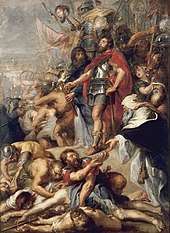
- Matityahu the High Priest, also referred to as Mattathias and Mattathias ben Johanan. Matityahu was a Jewish High Priest who, together with his five sons, played a central role in the story of Hanukkah.[59]
- Judah the Maccabee, also referred to as Judas Maccabeus and Y'hudhah HaMakabi. Judah was the eldest son of Matityahu and is acclaimed as one of the greatest warriors in Jewish history alongside Joshua, Gideon, and David.[60]
- Eleazar the Maccabee, also referred to as Eleazar Avaran, Eleazar Maccabeus and Eleazar Hachorani/Choran.
- Simon the Maccabee, also referred to as Simon Maccabeus and Simon Thassi.
- Johanan the Maccabee, also referred to as Johanan Maccabeus and John Gaddi.
- Jonathan the Maccabee, also referred to as Jonathan Apphus.
- Antiochus IV Epiphanes. Seleucid emperor controlling the region during this period.
- Judith. Acclaimed for her heroism in the assassination of Holofernes.[61][62]
- Hannah and her seven sons. Arrested, tortured and killed one by one, by Antiochus IV Epiphanes for refusing to bow to an idol.[63]
Rituals
.jpg)
.jpg)
Hanukkah is celebrated with a series of rituals that are performed every day throughout the 8-day holiday, some are family-based and others communal. There are special additions to the daily prayer service, and a section is added to the blessing after meals.[64]
Hanukkah is not a "Sabbath-like" holiday, and there is no obligation to refrain from activities that are forbidden on the Sabbath, as specified in the Shulkhan Arukh.[65][66] Adherents go to work as usual but may leave early in order to be home to kindle the lights at nightfall. There is no religious reason for schools to be closed, although in Israel schools close from the second day for the whole week of Hanukkah.[67][68] Many families exchange gifts each night, such as books or games, and "Hanukkah Gelt" is often given to children. Fried foods (such as latkes (potato pancakes), jelly doughnuts (sufganiyot), and Sephardic bimuelos) are eaten to commemorate the importance of oil during the celebration of Hanukkah. Some also have a custom of eating dairy products to remember Judith and how she overcame Holofernes by feeding him cheese, which made him thirsty, and giving him wine to drink. When Holofernes became very drunk, Judith cut off his head.[69]
Kindling the Hanukkah lights
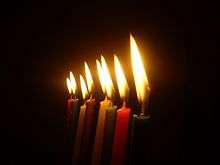
Each night throughout the 8 day holiday, a candle or oil-based light is lit. As a universally practiced "beautification" (hiddur mitzvah) of the mitzvah, the number of lights lit is increased by one each night.[70] An extra light called a shamash, meaning "attendant" or "sexton,"[71] is also lit each night, and is given a distinct location, usually higher, lower, or to the side of the others.[66]
Among Ashkenazim the tendency is for every male member of the household (and in many families, girls as well) to light a full set of lights each night,[72][73] while among Sephardim the prevalent custom is to have one set of lights for the entire household.[74]
The purpose of the shamash is to adhere to the prohibition, specified in the Talmud,[75] against using the Hanukkah lights for anything other than publicizing and meditating on the Hanukkah miracle. This differs from Sabbath candles which are meant to be used for illumination and lighting. Hence, if one were to need extra illumination on Hanukkah, the shamash candle would be available, and one would avoid using the prohibited lights. Some, especially Ashkenazim, light the shamash candle first and then use it to light the others.[76] So altogether, including the shamash, two lights are lit on the first night, three on the second and so on, ending with nine on the last night, for a total of 44 (36, excluding the shamash). It is Sephardic custom not to light the shamash first and use it to light the rest. Instead, the shamash candle is the last to be lit, and a different candle or a match is used to light all the candles. Some Hasidic Jews follow this Sephardic custom as well.[77]
The lights can be candles or oil lamps.[76] Electric lights are sometimes used and are acceptable in places where open flame is not permitted, such as a hospital room, or for the very elderly and infirm; however, those who permit reciting a blessing over electric lamps only allow it if it is incandescent and battery operated (an incandescent flashlight would be acceptable for this purpose), while a blessing may not be recited over a plug-in menorah or lamp. Most Jewish homes have a special candelabrum referred to as either a Chanukiah (the modern Israeli term) or a menorah (the traditional name, simply Hebrew for 'lamp'). Many families use an oil lamp (traditionally filled with olive oil) for Hanukkah. Like the candle Chanukiah, it has eight wicks to light plus the additional shamash light.[78]
In the United States, Hanukkah became a more visible festival in the public sphere from the 1970s when Rabbi Menachem M. Schneerson called for public awareness and observance of the festival and encouraged the lighting of public menorahs.[79][80][81][82] Diane Ashton attributed the increased visibility and reinvention of Hanukkah by some of the American Jewish community as a way to adapt to American life, re-inventing the festival in "the language of individualism and personal conscience derived from both Protestantism and the Enlightenment".[83]
The reason for the Hanukkah lights is not for the "lighting of the house within", but rather for the "illumination of the house without," so that passersby should see it and be reminded of the holiday's miracle (i.e. that the sole cruse of pure oil found which held enough oil to burn for one night actually burned for eight nights). Accordingly, lamps are set up at a prominent window or near the door leading to the street. It is customary amongst some Ashkenazi Jews to have a separate menorah for each family member (customs vary), whereas most Sephardi Jews light one for the whole household. Only when there was danger of antisemitic persecution were lamps supposed to be hidden from public view, as was the case in Persia under the rule of the Zoroastrians, or in parts of Europe before and during World War II. However, most Hasidic groups light lamps near an inside doorway, not necessarily in public view. According to this tradition, the lamps are placed on the opposite side from the mezuzah, so that when one passes through the door s/he is surrounded by the holiness of mitzvot (the commandments).[84]
Generally, women are exempt in Jewish law from time-bound positive commandments, although the Talmud requires that women engage in the mitzvah of lighting Hanukkah candles "for they too were involved in the miracle."[85][86]
Candle-lighting time
Hanukkah lights should usually burn for at least half an hour after it gets dark.[87] The custom of many is to light at sundown, although most Hasidim light later.[87] Many Hasidic Rebbes light much later to fulfill the obligation of publicizing the miracle by the presence of their Hasidim when they kindle the lights.[88]
Inexpensive small wax candles sold for Hanukkah burn for approximately half an hour so should be lit no earlier than nightfall.[87] Friday night presents a problem, however. Since candles may not be lit on Shabbat itself, the candles must be lit before sunset.[87] However, they must remain lit through the lighting of the Shabbat candles. Therefore, the Hanukkah menorah is lit first with larger candles than usual,[87] followed by the Shabbat candles. At the end of the Shabbat, there are those who light the Hanukkah lights before Havdalah and those who make Havdalah before the lighting Hanukkah lights.[89]
If for whatever reason one didn't light at sunset or nightfall, the lights should be kindled later, as long as there are people in the streets.[87] Later than that, the lights should still be kindled, but the blessings should be recited only if there is at least somebody else awake in the house and present at the lighting of the Hannukah lights.[90]
Blessings over the candles
Typically two blessings (brachot; singular: brachah) are recited during this eight-day festival when lighting the candles. On the first night, the shehecheyanu blessing is added, making a total of three blessings.[91]
The blessings are said before or after the candles are lit depending on tradition. On the first night of Hanukkah one light (candle or oil) is lit on the right side of the menorah, on the following night a second light is placed to the left of the first but it is lit first, and so on, proceeding from placing candles right to left but lighting them from left to right over the eight nights.[92]
Blessing for lighting the candles
בָּרוּךְ אַתָּה ה', אֱ-לֹהֵינוּ מֶלֶךְ הָעוֹלָם, אֲשֶׁר קִדְּשָׁנוּ בְּמִצְוֹתָיו, וְצִוָּנוּ לְהַדְלִיק נֵר חֲנֻכָּה.[93]
Transliteration: Barukh ata Adonai Eloheinu, melekh ha'olam, asher kid'shanu b'mitzvotav v'tzivanu l'hadlik ner Hanukkah.
Translation: "Blessed are You, LORD our God, King of the universe, Who has sanctified us with His commandments and commanded us to kindle the Hanukkah light[s]."
Blessing for the miracles of Hanukkah
בָּרוּךְ אַתָּה ה' אֱ-לֹהֵינוּ מֶלֶךְ הָעוֹלָם, שֶׁעָשָׂה נִסִּים לַאֲבוֹתֵֽינוּ בַּיָּמִים הָהֵם בַּזְּמַן הַזֶּה.[93]
Transliteration: Barukh ata Adonai Eloheinu, melekh ha'olam, she'asa nisim la'avoteinu ba'yamim ha'heim ba'z'man ha'ze.
Translation: "Blessed are You, LORD our God, King of the universe, Who performed miracles for our ancestors in those days at this time..."
Hanerot Halalu
After the lights are kindled the hymn Hanerot Halalu is recited. There are several different versions; the version presented here is recited in many Ashkenazic communities:[94]
| Hebrew | Transliteration | English |
|---|---|---|
| הנרות הללו אנו מדליקין על הנסים ועל הנפלאות ועל התשועות ועל המלחמות שעשית לאבותינו בימים ההם, בזמן הזה על ידי כהניך הקדושים. וכל שמונת ימי חנוכה הנרות הללו קודש הם, ואין לנו רשות להשתמש בהם אלא להאיר אותם בלבד כדי להודות ולהלל לשמך הגדול על נסיך ועל נפלאותיך ועל ישועותיך. | Hanneirot hallalu anu madlikin 'al hannissim ve'al hanniflaot 'al hatteshu'ot ve'al hammilchamot she'asita laavoteinu bayyamim haheim, (u)bazzeman hazeh 'al yedei kohanekha hakkedoshim. Vekhol-shemonat yemei Hanukkah hanneirot hallalu kodesh heim, ve-ein lanu reshut lehishtammesh baheim ella lir'otam bilvad kedei lehodot ul'halleil leshimcha haggadol 'al nissekha ve'al nifleotekha ve'al yeshu'otekha. | We kindle these lights for the miracles and the wonders, for the redemption and the battles that you made for our forefathers, in those days at this season, through your holy priests. During all eight days of Hanukkah these lights are sacred, and we are not permitted to make ordinary use of them except for to look at them in order to express thanks and praise to Your great Name for Your miracles, Your wonders and Your salvations. |
Maoz Tzur
In the Ashkenazi tradition, each night after the lighting of the candles, the hymn Ma'oz Tzur is sung. The song contains six stanzas. The first and last deal with general themes of divine salvation, and the middle four deal with events of persecution in Jewish history, and praises God for survival despite these tragedies (the exodus from Egypt, the Babylonian captivity, the miracle of the holiday of Purim, the Hasmonean victory), and a longing for the days when Judea will finally triumph over Rome.[95]
The song was composed in the thirteenth century by a poet only known through the acrostic found in the first letters of the original five stanzas of the song: Mordechai. The familiar tune is most probably a derivation of a German Protestant church hymn or a popular folk song.[96]
Other customs
After lighting the candles and Ma'oz Tzur, singing other Hanukkah songs is customary in many Jewish homes. Some Hasidic and Sephardi Jews recite Psalms, such as Psalm 30, Psalm 67, and Psalm 91. In North America and in Israel it is common to exchange presents or give children presents at this time. In addition, many families encourage their children to give tzedakah (charity) in lieu of presents for themselves.[97][98]
Special additions to daily prayers
Translation of Al ha-Nissim[99]
An addition is made to the "hoda'ah" (thanksgiving) benediction in the Amidah (thrice-daily prayers), called Al HaNissim ("On/about the Miracles").[100] This addition refers to the victory achieved over the Syrians by the Hasmonean Mattathias and his sons.[101][102]
The same prayer is added to the grace after meals. In addition, the Hallel (praise) Psalms (Psalm 113 – Psalm 118) are sung during each morning service and the Tachanun penitential prayers are omitted.[101][103]
The Torah is read every day in the shacharit morning services in synagogue, on the first day beginning from Numbers 6:22 (according to some customs, Numbers 7:1), and the last day ending with Numbers 8:4. Since Hanukkah lasts eight days it includes at least one, and sometimes two, Jewish Sabbaths (Saturdays). The weekly Torah portion for the first Sabbath is almost always Miketz, telling of Joseph's dream and his enslavement in Egypt. The Haftarah reading for the first Sabbath Hanukkah is Zechariah 2:14 – Zechariah 4:7. When there is a second Sabbath on Hanukkah, the Haftarah reading is from 1Kings 7:40 – 1Kings 7:50.
The Hanukkah menorah is also kindled daily in the synagogue, at night with the blessings and in the morning without the blessings.[104]
The menorah is not lit during Shabbat, but rather prior to the beginning of Shabbat as described above and not at all during the day. During the Middle Ages "Megillat Antiochus" was read in the Italian synagogues on Hanukkah just as the Book of Esther is read on Purim. It still forms part of the liturgy of the Yemenite Jews.[105]
Zot Hanukkah
The last day of Hanukkah is known by some as Zot Hanukkah and by others as Chanukat HaMizbeach, from the verse read on this day in the synagogue Numbers 7:84, Zot Hanukkat Hamizbe'ach: "This was the dedication of the altar". According to the teachings of Kabbalah and Hasidism, this day is the final "seal" of the High Holiday season of Yom Kippur and is considered a time to repent out of love for God. In this spirit, many Hasidic Jews wish each other Gmar chatimah tovah ("may you be sealed totally for good"), a traditional greeting for the Yom Kippur season. It is taught in Hasidic and Kabbalistic literature that this day is particularly auspicious for the fulfillment of prayers.[106]
Other related laws and customs
It is customary for women not to work for at least the first half-hour of the candles' burning, and some have the custom not to work for the entire time of burning. It is also forbidden to fast or to eulogize during Hanukkah.[66]
Customs
Music
A large number of songs have been written on Hanukkah themes, perhaps more so than for any other Jewish holiday. Some of the best known are "Ma'oz Tzur" (Rock of Ages), "Latke'le Latke'le" (Yiddish song about cooking Latkes), "Hanukkiah Li Yesh" ("I Have a Hanukkah Menorah"), "Ocho Kandelikas" ("Eight Little Candles"), "Kad Katan" ("A Small Jug"), "S'vivon Sov Sov Sov" ("Dreidel, Spin and Spin"), "Haneirot Halolu" ("These Candles which we light"), "Mi Yimalel" ("Who can Retell") and "Ner Li, Ner Li" ("I have a Candle"). Among the most well known songs in English-speaking countries are "Dreidel, Dreidel, Dreidel"[107] and "Oh Chanukah".[108]
Among the Rebbes of the Nadvorna Hasidic dynasty, it is customary for the Rebbes to play violin after the menorah is lit.[109]
Penina Moise's Hannukah Hymn published in the 1842 Hymns Written for the Use of Hebrew Congregations was instrumental in the beginning of Americanization of Hanukkah.[83][110][111]
Foods
There is a custom of eating foods fried or baked in oil (preferably olive oil) to commemorate the miracle of a small flask of oil keeping the Second Temple's Menorah alight for eight days.[112] Traditional foods include latkes, a fried potato fritter, especially among Ashkenazi families. Sephardi, Polish, and Israeli families eat jam-filled doughnuts called sufganiyot, which were (Yiddish: פאנטשקעס pontshkes) by Ashkenazi Jews living in Eastern and Central Europe prior to the Holocaust, bimuelos (spherical doughnuts) and sufganiyot which are deep-fried in oil. Italkim and Hungarian Jews traditionally eat cheese pancakes known as "cassola" or "cheese latkes".[113]
Latkes are not popular in Israel, as they are more commonly made at home and are an Ashkenazi Jewish dish. The Sephardi Jews eat fritas de prasa, a similar fried dish made with mashed potato and leek. As the majority of the population in Israel is of Sephardi and Mizrahi Jewish descent, and these groups have their own Hanukkah dishes such as fritas de prasa, sfinj, cassola, and shamlias, among others. Latkes have also been largely replaced by sufganiyot due to local economic factors, convenience and the influence of trade unions.[114] Bakeries in Israel have popularized many new types of fillings for sufganiyot besides the traditional strawberry jelly filling, including chocolate cream, vanilla cream, caramel, cappuccino and others.[115] In recent years, downsized, "mini" sufganiyot containing half the calories of the regular, 400-to-600-calorie version, have become popular.[116]
Rabbinic literature also records a tradition of eating cheese and other dairy products during Hanukkah.[117] This custom, as mentioned above, commemorates the heroism of Judith during the Babylonian captivity of the Jews and reminds us that women also played an important role in the events of Hanukkah.[118] The deuterocanonical book of Judith (Yehudit or Yehudis in Hebrew), which is not part of the Tanakh, records that Holofernes, an Assyrian general, had surrounded the village of Bethulia as part of his campaign to conquer Judea. After intense fighting, the water supply of the Jews was cut off and the situation became desperate. Judith, a pious widow, told the city leaders that she had a plan to save the city. Judith went to the Assyrian camps and pretended to surrender. She met Holofernes, who was smitten by her beauty. She went back to his tent with him, where she plied him with cheese and wine. When he fell into a drunken sleep, Judith beheaded him and escaped from the camp, taking the severed head with her (the beheading of Holofernes by Judith has historically been a popular theme in art). When Holofernes' soldiers found his corpse, they were overcome with fear; the Jews, on the other hand, were emboldened and launched a successful counterattack. The town was saved, and the Assyrians defeated.[119]
Roast goose has historically been a traditional Hanukkah food among Eastern European and American Jews, although the custom has declined in recent decades.[120]
Indian Jews traditionally consume gulab jamun, fried dough balls soaked in a sweet syrup, similar to teiglach or bimuelos, as part of their Hanukkah celebrations. Italian Jews eat fried chicken, cassola (a ricotta cheese latke almost similar to a cheesecake), and Fritelle de riso par Hanukkah (a fried sweet rice pancake). Romanian Jews eat pasta latkes as a traditional Hanukkah dish, and Syrian Jews consume Kibbet Yatkeen, a dish made with pumpkin and bulgur wheat similar to latkes, as well as their own version of keftes de prasa spiced with allspice and cinnamon.[121]
Dreidel
After lighting the candles, it is customary to play (or spin) the dreidel. The dreidel, or sevivon in Hebrew, is a four-sided spinning top that children play with during Hanukkah. Each side is imprinted with a Hebrew letter which is an abbreviation for the Hebrew words נס גדול היה שם (Nes Gadol Haya Sham, "A great miracle happened there"), referring to the miracle of the oil that took place in the Beit Hamikdash. The fourth side of some dreidels sold in Israel are inscribed with the letter פ (Pe), rendering the acronym נס גדול היה פה (Nes Gadol Haya Po, "A great miracle happened here"), referring to the fact that the miracle occurred in the land of Israel, although this is a relatively recent innovation. Stores in Haredi neighborhoods sell the traditional Shin dreidels as well, because they understand "there" to refer to the Temple and not the entire Land of Israel, and because the Hasidic Masters ascribe significance to the traditional letters.[122][123]
Hanukkah gelt
Chanukkah gelt (Yiddish for "Chanukkah money") known in Israel by the Hebrew translation dmei Hanukkah, is often distributed to children during the festival of Hanukkah. The giving of Hanukkah gelt also adds to the holiday excitement. The amount is usually in small coins, although grandparents or relatives may give larger sums. The tradition of giving Chanukah gelt dates back to a long-standing East European custom of children presenting their teachers with a small sum of money at this time of year as a token of gratitude. One minhag favors the fifth night of Hanukkah for giving Hanukkah gelt.[124] Unlike the other nights of Hanukkah, the fifth does not ever fall on the Shabbat, hence never conflicting with the Halachic injunction against handling money on the Shabbat.[125]
Hanukkah in the White House

The United States has a history of recognizing and celebrating Hanukkah in a number of ways. The earliest Hanukkah link with the White House occurred in 1951 when Israeli Prime Minister David Ben-Gurion presented United States President Harry Truman with a Hanukkah Menorah. In 1979 president Jimmy Carter took part in the first public Hanukkah candle-lighting ceremony of the National Menorah held across the White House lawn. In 1989, President George H.W. Bush displayed a menorah in the White House. In 1993, President Bill Clinton invited a group of schoolchildren to the Oval Office for a small ceremony.[80]
The United States Postal Service has released several Hanukkah-themed postage stamps. In 1996 the United States Postal Service (USPS) issued a 32 cent Hanukkah stamp as a joint issue with Israel.[126] In 2004 after 8 years of reissuing the menorah design, the USPS issued a dreidel design for the Hanukkah stamp. The dreidel design was used through 2008. In 2009 a Hanukkah stamp was issued with a design featured a photograph of a menorah with nine lit candles.[127]
In 2001, President George W. Bush held an official Hanukkah reception in the White House in conjunction with the candle-lighting ceremony, and since then this ceremony has become an annual tradition attended by Jewish leaders from around the country.[128] In 2008, George Bush linked the occasion to the 1951 gift by using that menorah for the ceremony, with a grandson of Ben-Gurion and a grandson of Truman lighting the candles.[129]
In December 2014, two Hanukkah celebrations were held at the White House. The White House commissioned a menorah made by students at the Max Rayne school in Israel and invited two of its students to join U.S. President Barack Obama and First Lady Michelle Obama as they welcomed over 500 guests to the celebration. The students' school in Israel had been subjected to arson by extremists. President Obama said these "students teach us an important lesson for this time in our history. The light of hope must outlast the fires of hate. That's what the Hanukkah story teaches us. It's what our young people can teach us – that one act of faith can make a miracle, that love is stronger than hate, that peace can triumph over conflict."[130] Rabbi Angela Warnick Buchdahl, in leading prayers at the ceremony commented on the how special the scene was, asking the President if he believed America's founding fathers could possibly have pictured that a female Asian-American rabbi would one day be at the White House leading Jewish prayers in front of the African-American president.[131]
Dates
The dates of Hanukkah are determined by the Hebrew calendar. Hanukkah begins at the 25th day of Kislev and concludes on the 2nd or 3rd day of Tevet (Kislev can have 29 or 30 days). The Jewish day begins at sunset. Hanukkah dates for recent and upcoming:
- Sunset, 12 December 2017 – nightfall, 20 December 2017[1]
- Sunset, 2 December 2018 – nightfall, 10 December 2018
- Sunset, 22 December 2019 – nightfall, 30 December 2019
- Sunset, 10 December 2020 – nightfall, 18 December 2020
- Sunset, 28 November 2021 – nightfall, 6 December 2021
- Sunset, 18 December 2022 – nightfall, 26 December 2022
- Sunset, 7 December 2023 – nightfall, 15 December 2023
- Sunset, 25 December 2024 – nightfall, 2 January 2025
In 2013, on 28 November, the American holiday of Thanksgiving fell during Hanukkah for only the third time since Thanksgiving was declared a national holiday by President Abraham Lincoln. The last time was 1899; and due to the Gregorian and Jewish calendars being slightly out of sync with each other, it will not happen again in the foreseeable future.[132] This convergence prompted the creation of the portmanteau neologism Thanksgivukkah.[133][134][135]
Symbolic importance
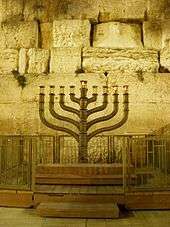
Major Jewish holidays are those when all forms of work are forbidden, and that feature traditional holiday meals, kiddush, holiday candle-lighting, etc. Only biblical holidays fit these criteria, and Chanukah was instituted some two centuries after the Hebrew Bible was completed. Nevertheless, though Chanukah is of rabbinic origin, it is traditionally celebrated in a major and very public fashion. The requirement to position the menorah, or Chanukiah, at the door or window, symbolizes the desire to give the Chanukah miracle a high-profile.[136]
Some Jewish historians suggest a different explanation for the rabbinic reluctance to laud the militarism. First, the rabbis wrote after Hasmonean leaders had led Judea into Rome's grip and so may not have wanted to offer the family much praise. Second, they clearly wanted to promote a sense of dependence on God, urging Jews to look toward the divine for protection. They likely feared inciting Jews to another revolt that might end in disaster, as the Bar Kochba revolt did.[137]
With the advent of Zionism and the state of Israel, however, these themes were reconsidered. In modern Israel, the national and military aspects of Hanukkah became, once again, more dominant.[138][139]
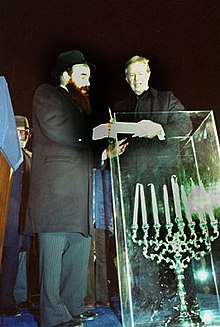
In North America especially, Hanukkah gained increased importance with many Jewish families in the latter part of the 20th century, including among large numbers of secular Jews, who wanted a Jewish alternative to the Christmas celebrations that often overlap with Hanukkah.[140] Though it was traditional among Ashkenazi Jews to give "gelt" or money to children during Hanukkah, in many families this has been supplemented with other gifts so that Jewish children can enjoy gifts just as their Christmas-celebrating peers do.[141]
While Hanukkah is a relatively minor Jewish holiday, as indicated by the lack of religious restrictions on work other than a few minutes after lighting the candles, in North America, Hanukkah in the 21st century has taken a place equal to Passover as a symbol of Jewish identity. Both the Israeli and North American versions of Hanukkah emphasize resistance, focusing on some combination of national liberation and religious freedom as the defining meaning of the holiday.[142][4]
Some Jews in North America and Israel have taken up environmental concerns in relation to Hanukkah's "miracle of the oil", emphasizing reflection on energy conservation and energy independence. An example of this is the Coalition on the Environment and Jewish Life's renewable energy campaign.[143][144][145]
See also
References
- "Dates for Hanukkah". Hebcal.com by Danny Sadinoff and Michael J. Radwin (CC-BY-3.0). Retrieved 26 August 2018.
- "How to Light the Menorah". chabad.org. Archived from the original on 5 June 2017. Retrieved 6 October 2018.
- "JTA NEWS". Joi.org. Archived from the original on 6 October 2007.
- Moyer, Justin (22 December 2011). "The Christmas effect: How Hanukkah became a big holiday". Washington Post. Retrieved 30 December 2019.
- "Hanukkah". bbc.co.uk. 17 December 2014. Archived from the original on 26 December 2018. Retrieved 12 May 2019.
- Goldman, Ari L. (2000). Being Jewish: The Spiritual and Cultural Practice of Judaism Today. Simon & Schuster. p. 141. ISBN 978-0-684-82389-8.
- Scherman, Nosson. "Origin of the Name Chanukah". Torah.org. Archived from the original on 7 December 2012. Retrieved 6 October 2018.
- Ran Shabbat 9b ("Hebrew text". Retrieved 6 October 2018.)
- "The Lights of Chanukah: Laws and Customs". Orthodox Union. 9 April 2014. Retrieved 6 October 2018.
- "Yes, Virginia, Hanukkah Has a Correct Spelling".
- "Is There a Right Way to Spell Hanukkah? Chanukah? Hannukah?". Time.
- "Definition of HANUKKAH". www.merriam-webster.com.
- Powney, Harriet (7 December 2012). "Hanukah or Chanukah? Have the chutzpah to embrace Yiddish". the Guardian.
- Its use in transliteration of Hebrew into English is based on influences of Yiddish and German, particularly since transliteration into German tended to be earlier than transliteration into English. See Romanization of Hebrew § How to transliterate.
- Stergiou, Fr. R. "The Old Testament in the Orthodox Church". OrthodoxChristian.info. Retrieved 6 October 2018.
- Bikkurim 1:6, Rosh HaShanah 1:3, Taanit 2:10, Megillah 3:4 and 3:6, Moed Katan 3:9, and Bava Kama 6:6
- In his Hakdamah Le'mafteach Hatalmud
- Yesod Hamishna Va'arichatah pp. 25–28 ("Hebrew text". Retrieved 6 October 2018.)
- Dolanksy, Shawna (23 December 2011). "The Truth(s) About Hanukkah". Huffington Post. Retrieved 6 October 2018.
- Shabbat 21b
- "Babylonian Talmud: Shabbath 21b". sefaria.org. Sefaria. Retrieved 5 May 2019.
- "Sukkah 46a:8". www.sefaria.org. Retrieved 6 October 2018.
- Zvieli, Benjamin. "The Scroll of Antiochus". Retrieved 6 October 2018.
- Hubarah, Yosef (1964). מגלת בני חשמונאי [Sefer Ha-Tiklāl (Tiklal Qadmonim)]. Jerusalem. pp. 75b–79b. Original Aramaic text:בָּתַר דְּנָּא עָלוּ בְּנֵי יִשְׂרָאֵל לְבֵית מַקְדְּשָׁא וּבְנוֹ תַּרְעַיָּא וְדַכִּיאוּ בֵּית מַקְדְּשָׁא מִן קְטִילַיָּא וּמִן סְאוֹבֲתָא. וּבעוֹ מִשְׁחָא דְּזֵיתָא דָּכְיָא לְאַדְלָקָא בּוֹצִנַיָּא וְלָא אַשְׁכַּחוּ אֵלָא צְלוֹחִית חֲדָא דַּהֲוָת חֲתִימָא בְּעִזְקָת כָּהֲנָא רַבָּא מִיּוֹמֵי שְׁמוּאֵל נְבִיָּא וִיַדְעוּ דְּהִיא דָּכְיָא. בְּאַדְלָקוּת יוֹמָא חֲדָא הֲוָה בַּהּ וַאֲלָה שְׁמַיָּא דִּי שַׁכֵין שְׁמֵיהּ תַּמָּן יְהַב בַּהּ בִּרְכְּתָא וְאַדְלִיקוּ מִנַּהּ תְּמָנְיָא יוֹמִין. עַל כֵּן קַיִּימוּ בְּנֵי חַשְׁמוּנַּאי הָדֵין קְיָימָא וַאֲסַרוּ הָדֵין אֲסָּרָא אִנּוּן וּבְנֵי יִשְׂרָאֵל כּוּלְּהוֹן. לְהוֹדָעָא לִבְנֵי יִשְׂרָאֵל לְמֶעֲבַד הָדֵין תְּמָנְיָא יוֹמִין חַדְוָא וִיקָר כְּיּוֹמֵי מוֹעֲדַיָּא דִּכְתִיבִין בְּאוֹרָיְתָא לְאַדְלָקָא בְּהוֹן לְהוֹדָעָא לְמַן דְּיֵּיתֵי מִבַּתְרֵיהוֹן אֲרֵי עֲבַד לְהוֹן אֱלָהֲהוֹן פּוּרְקָנָא מִן שְׁמַיָּא. בְּהוֹן לָא לְמִסְפַּד וְלָא לְמִגְזַר צוֹמָא וְכָל דִּיהֵי עֲלוֹהִי נִדְרָא יְשַׁלְּמִנֵּיהּ
- Babylonian Talmud, Berachot 28a
- Josephus (1930). "Jewish Antiquities". doi:10.4159/DLCL.josephus-jewish_antiquities.1930. Retrieved 6 October 2018. Cite journal requires
|journal=(help) – via digital Loeb Classical Library (subscription required) - Perseus.tufts.edu, Jewish Antiquities xii. 7, § 7, #323
- This is the first reference to the Feast of Dedication by this name (ta egkainia, ta enkainia [a typical "festive plural"]) in Jewish literature (Hengel 1999: 317). "
- Roth, Andrew Gabriel (2008). Aramaic English New Testament, 3rd Ed. Netzari Press LLV. p. 266.
- Sacchi, Paolo (2004). The History of the Second Temple Period. Bloomsbury Publishing. ISBN 978-0-567-04450-1.
- "T. Livivs". TheLatinLibrary.com. Retrieved 6 October 2018.
- Josephus, Flavius. "The Wars of the Jews i. 31". Retrieved 6 October 2018.
- Josephus, Flavius (1825). "The Works of Flavius Josephus" – via Google Books.
- Josephus, Flavius. "The Wars of the Jews i. 34". Retrieved 6 October 2018.
- "1 Maccabees". EarlyJewishWritings.com. Retrieved 6 October 2018.
- "1 Macc. iv. 59". Archived from the original on 27 June 2004.
- Epstein, Baruch. "All's Well – When it Ends". Chabad.org. Retrieved 6 October 2018.
- "1 Macc. iv. 36". Archived from the original on 16 January 2008.
- Telushkin, Joseph (1991). Jewish Literacy: The Most Important Things to Know about the Jewish Religion, Its People, and Its History. W. Morrow. p. 114. ISBN 978-0-688-08506-3.
- Johnston, Sarah Iles (2004). Religions of the Ancient World: A Guide. Harvard University Press. p. 186. ISBN 978-0-674-01517-3.
- Greenberg, Irving (1993). The Jewish Way: Living the Holidays. Simon & Schuster. p. 29. ISBN 978-0-671-87303-5.
- Schultz, Joseph P. (1981). Judaism and the Gentile Faiths: Comparative Studies in Religion. Fairleigh Dickinson University Press. p. 155. ISBN 978-0-8386-1707-6.
Modern scholarship on the other hand considers the Maccabean revolt less as an uprising against foreign oppression than as a civil war between the orthodox and reformist parties in the Jewish camp
- Gundry, Robert H. (2003). A Survey of the New Testament. Zondervan. p. 9. ISBN 978-0-310-23825-6.
- Grabbe, Lester L. (2000). Judaic Religion in the Second Temple Period: Belief and Practice from the Exile to Yavneh. Routledge. p. 59. ISBN 978-0-415-21250-2.
- Freedman, David Noel; Allen C. Myers; Astrid B. Beck (2000). Eerdmans Dictionary of the Bible. Wm.B. Eerdmans Publishing. p. 837. ISBN 978-0-8028-2400-4.
- Wood, Leon James (1986). A Survey of Israel's History. Zondervan. p. 357. ISBN 978-0-310-34770-5.
- Tcherikover, Victor (1999) [1959]. Hellenistic Civilization and the Jews. Baker Academic. ISBN 978-0-8010-4785-5.
- Skolnik, Berenbaum, Fred, Michael (2007). Encyclopaedia Judaica, Volume 9. Granite Hill Publishers. p. 332.
- Frankiel, Rabbi Yaakov. "Why Eight Days?". Archived from the original on 13 December 2017. Retrieved 6 October 2018.
- M. Zambelli, "L'ascesa al trono di Antioco IV Epifane di Siria," Rivista di Filologia e di Istruzione Classica 38 (1960) 363–389
- Newsom, Carol Ann; Breed, Brennan W. (2014). Daniel: A Commentary. Presbyterian Publish Corp. p. 26. ISBN 978-0-664-22080-8.
- Josephus, Ant. xiii, 9:1., via
- 1 Maccabees 8:17–20
- Smith, Mahlon H. "Antiochus VII Sidetes". Retrieved 6 October 2018.
- Ginzburg, Louis (1901). "Antiochus VII., Sidetes". Jewish Encyclopedia. Retrieved 6 October 2018.
- Ginzberg, Louis. "ALEXANDER JANNÆUS (Jonathan)". Retrieved 6 October 2018. Jewish Encyclopedia.
- Ginzberg, Louis. "ALEXANDER JANNÆUS (Jonathan)". Retrieved 6 October 2018.
His three years' war east of the Jordan (about 85–82) was successful; and he conquered Pella, Dium, Gerasa, Gaulana, Seleucia, and the strong fortress Gamala.
Jewish Encyclopedia. - Josephus, Antiquities of the Jews 14:70–71
- Missler, Dr. Chuck. "Happy Hanukkah". Retrieved 6 October 2018.
Mattathias and his five sons became the nucleus of a growing band of rebels against Antiochus.
- Saundra L. Washington (2010). God's Intertestamental Silence: Then Came Jesus Christ. p. 14. ISBN 978-1-4523-9735-1.
- "On Hanukkah, Women As Role Models". Retrieved 6 October 2018.
Also in the Apocrypha is the Book of Judith, which tells how this heroine stopped the siege of Jerusalem by decapitating Holofernes, a major military leader for the enemy.
- "December: Judith and the Hanukkah Story". Retrieved 6 October 2018.
For several centuries there was another hero associated with Hanukkah: Judith.
- Dice, Elizabeth A. (2009). Christmas and Hanukkah. Infobase Publishing. p. 24. ISBN 978-1-4381-1971-7.
- "Chanukah with Torah Tidbits". OU.org. 29 June 2006. Retrieved 6 October 2018.
- Shulkhan Arukh Orach Chayim 670:1
- Becher, Rabbi Mordechai. "The Laws of Chanukah". Ohr.edu. Retrieved 6 October 2018.
- Skop, Yarden (24 March 2014). "Education Ministry Changes Start of School Year – Again". Haaretz. Retrieved 6 October 2018 – via Haaretz.
- "לוח החופשות והימים המיוחדים לשנת תשע"ח". Edu.gov.il. Retrieved 6 October 2018.
- Glazer, Rabbi Chalm. "Chanukah: Performances and Customs". Kashrut.com. Retrieved 6 October 2018.
- Shulkhan Arukh Orach Chayim 671:2
- "How to Light the Menorah – Light Up Your Environment!". Chabad.org. Retrieved 6 October 2018.
- Aiken, Richard B. (30 November 2015). "Halacha L'Maaseh on Chanuka". Orthodox Union. Retrieved 6 October 2018.
- Posner, Menachem. "Why Don't Women Work While the Chanukah Candles Are Burning?". Chabad-Lubavitch Media Center. Retrieved 6 October 2018.
- "Hakirah Volume 25, Fall 2018" (PDF). Hakirah.org. Retrieved 6 October 2018.
- Tractate Shabbat 21b–23a
- Shulkhan Arukh Orach Chayim 673:1
- "The following is a response from Hakham Ya'aqob Menashe". Midrash.org. Retrieved 6 October 2018.
- "OU's Chanukah Guide". Orthodox Union. Retrieved 6 October 2018.
- Plaut, Joshua Eli (2012). A Kosher Christmas: 'Tis the Season to be Jewish. Rutgers University Press. p. 167.
- Sarna, Jonathan D. (2 December 2009). "How Hanukkah Came to the White House". Forward. Retrieved 6 October 2018.
- Telushkin, Joseph (2014). Rebbe: The Life and Teachings of Menachem M. Schneerson, the Most Influential Rabbi in Modern History. HarperCollins. p. 269.
- Posner, Menachem (1 December 2014). "40 Years Later: How the Chanukah Menorah Made Its Way to the Public Sphere". Retrieved 6 October 2018.
- Ashton, Dianne (2013). Hanukkah in America: A History. NYU Press. pp. 42–46. ISBN 978-1-4798-5895-8.
Throughout the nineteenth century some Jews tried various ways to adapt Judaism to American life. As they began looking for images to help understand and explain what a proper response to American Challenges might be, Hanukkah became ripe for reinvention. In Charleston, South Carolina, one group of Jews made Hanukkah into a time for serious religious reflexion that responded to their evangelical Protestant milieu...[Moise's] poem gave Hanukkah a place in the emerging religious style of American culture that was dominated by the language of individualism and personal conscience derived from both Protestantism and the Enlightenment. However, neither the Talmud nor the Shulchan Aruch identifies Hanukkah as a special occasion to ask for the forgiveness of sins.
- "Shabbat 22a".
- Babylonian Talmud: Shabbat 23a
- Yosef, Rabbeinu Ovadia (11 December 2017). "The Obligation of Women Regarding Chanukah Candles". Halachayomit.co.il. Retrieved 6 October 2018.
- "How to Celebrate Chanukah". Retrieved 6 October 2018.
[...] the menorah must contain enough fuel at the time of the lighting to burn until 30 minutes after nightfall.
- "Some Light Chanukah Questions". 25 November 2013. Retrieved 6 October 2018.
- "CTI Laws and Customs of Chanukah". 5 November 2015. Archived from the original on 1 January 2017.
- "What to do on Chanukah". Retrieved 6 October 2018.
- Shulkhan Arukh Orach Chayim 676:1–2
- "The Lights of Chanukah: Laws and Customs". Orthodox Union. 9 April 2014. Retrieved 6 October 2018.
- Ross, Lesli Koppelman (2000). Celebrate!: The Complete Jewish Holidays Handbook. Jason Aronson, Incorporated. ISBN 978-1-4616-2772-2. Retrieved 6 October 2018.
- Shulkhan Arukh Orach Chayim 676:4
- "Maoz Tzur: Translation & Explanation – Jewish Holidays". Orthodox Union. 29 June 2006. Retrieved 6 October 2018.
- "Maoz Tzur: Rock of Ages". My Jewish Learning. Retrieved 6 October 2018.
- Newman, Bruce (7 December 2012). "Hanukkah ushers in 'tzedakah,' a religious obligation to do what is right and just". The Mercury News. Retrieved 6 October 2018.
- Maidenberg, Rhiana (11 December 2012). "The Fifth Night Project: Teaching Giving During Hanukkah". Retrieved 6 October 2018.
- Singer, Isidore (1905). "Chanukkah, or the Feast of Dedication". New Era Illustrated Magazine. 5: 621 – via Google Books.
- Shulkhan Arukh Orach Chayim 682:1
- "Chanukah with Torah Tidbits". Orthodox Union. 29 June 2006. Retrieved 6 October 2018.
- Nulman, Cantor Macy. "Al Hanisim: Concerning the Miracles". Retrieved 6 October 2018.
- Abramowitz, Rabbi Jack. "133. Days on Which Tachanun is Omitted". Orthodox Union. Retrieved 6 October 2018.
- Enkin, Rabbi Ari (7 December 2010). "Chanuka – Lighting in Shul". www.torahmusings.com. Retrieved 6 October 2018.
- Rahel. "The Scroll Of The Hasmoneans". Archived from the original on 28 May 2007.
- Gutfreund, Sara Debbie (23 December 2014). "Hanukkah's Last Light". Retrieved 6 October 2018.
- "Chanukah – Dreidel, Dreidel, Dreidel". Retrieved 6 October 2018.
As one of the most famous Chanukah songs...
- "Oh Chanukah (Jewish Traditional) sheet music for Trombone". Retrieved 6 October 2018.
Oh Chanukah (or Oj Chanukah) is a very popular modern English Chanukah song.
- Greenberg, Shlomo; Haredim, Behadrey (15 December 2012). "Belz resumed practice of playing violin at candle lighting". bhol.co.il. Retrieved 6 October 2018.
- Parker, Adam (18 December 2011). "Celebrating Hanukkah". The Post and Courier. Archived from the original on 5 January 2015. Retrieved 6 October 2018.
- Ashton, Dianne. "Quick to the Party: The Americanization of Hanukkah and Southern Jewry". Southern Jewish History. 12: 1–38.
- "Chanukah is upon us". The Philadelphia Jewish Voice. 7 January 2006. Retrieved 6 October 2018.
- Nathan, Joan (12 December 2006). "Hanukkah Q&A". The New York Times. Retrieved 6 October 2018.
- Jeffay, Nathan (17 December 2009). "Why Israel is a latke-free zone". thejc.com.
- Gur, Jana (2008). The Book of New Israeli Food: A Culinary Journey. Schocken. pp. 238–243. ISBN 978-0-8052-1224-2.
- Minsberg, Tali; Lidman, Melanie (10 December 2009). "Love Me Dough". The Jerusalem Post. Retrieved 6 October 2018.
- Soloveitchik, Benyamina. "Why All the Oil and Cheese (and Potatoes)?". Retrieved 6 October 2018.
- "The Story of Yehudit: The Woman Who Saved the Day". Chabad.org. Retrieved 6 October 2018.
- Mishna Berurah 670:2:10
-
- Cooper, John (1993). Eat and be Satisfied: A Social History of Jewish Food. Jason Aronson. p. 192. ISBN 978-0-87668-316-3.
- Fabricant, Florence (23 November 1994). "Hanukkah's a-Coming: Geese Are Getting Fat". The New York Times. Retrieved 6 October 2018.
- Yoskowitz, Jeffrey (24 December 2016). "Goose: A Hanukkah Tradition". The New York Times. Retrieved 6 October 2018.
- "8 Foods You Didn't Know Jews Eat During Hanukkah". My Jewish Learning. Retrieved 8 December 2019.
- Golinknin, Rabbi David. "The Surprising Origin of the Dreidel". Retrieved 6 October 2018.
- Rosenberg, Anat (14 December 2014). "Gyration Nation: The Weird Ancient History of the Dreidel". Haaretz. Retrieved 6 October 2018.
- Golinkin, Rabbi Prof. David (19 December 2014). "Why Do We Give Hanukkah Gelt and Hanukkah Presents?". The Schecter Institutes. Retrieved 6 October 2018.
- Lebowitz, Rabbi Aryeh (11 December 2005). "Chanukah Gelt and Gifts" (PDF). Dvarim Hayotzim Min Halev (PDF). Vol. 17 no. 6. p. 3. Retrieved 6 October 2018.
In fact, the Orchos Rabeinu in cheilek ג teaches that the Steipler Gaon maintained the minhag of giving out Chanukah gelt davka on the fifth night of Chanukah. Why specifically the fifth night? Answers the Orchos Rabeinu, since the fifth night is the only night that cannot coincide with Shabbos.
- "Israeli-American Hanukkah Stamp". Israel Ministry of Foreign Affairs. 22 October 1996. Retrieved 6 October 2018.
- Service, United States Postal. "Stamp Announcement 09-47: Hanukkah". Retrieved 6 October 2018.
- Braunstein, Melissa Langsam (11 December 2017). "5 Thoughts On The Furor Over The White House's Hanukkah Party". TheFederalist.com. Retrieved 6 October 2018.
- Donius, Susan K. (5 December 2013). "From the Archives: Hanukkah at the White House". Retrieved 6 October 2018.
- Ghert-Zand, Renee (18 December 2014). "Arab–Jewish school's menorah lights up White House Hanukkah party". TimesOfIsrael.com. Retrieved 6 October 2018.
- Eisner, Jane (18 December 2014). "A Most Inspiring Hanukkah at the White House". Forward.com. Retrieved 6 October 2018.
- Hoffman, Joel (24 November 2013). "Why Hanukkah and Thanksgiving Will Never Again Coincide". Huffington Post. Retrieved 6 October 2018.
- Spiro, Amy (17 November 2013). "Thanksgivukka: Please pass the turkey-stuffed doughnuts". The Jerusalem Post. Retrieved 6 October 2018.
- Byrne, Christine (2 October 2013). "How To Celebrate Thanksgivukkah, The Best Holiday Of All Time". Buzzfeed. Retrieved 6 October 2018.
- Stu Bykofsky (11 October 2013). "Thanks for Thanukkah!". The Inquirer. Retrieved 6 October 2018.
- "Chanukah FAQs". Chabad.org. Retrieved 6 October 2018.
- Ashton, Dianne (2013). Hanukkah in America: A History. New York: New York University Press. p. 29. ISBN 978-0-8147-0739-5.
- Haberman, Bonna (1 October 2014). Rereading Israel: The Spirit of the Matter. Urim Publications. p. 152. ISBN 978-965-524-202-7.
- Berkowitz, Michael (2004). Nationalism, Zionism and Ethnic Mobilization of the Jews in 1900 and Beyond. BRILL. p. 244. ISBN 978-90-04-13184-2.
- Abramitzky, Ran; Einav, Liran; Rigbi, Oren (1 June 2010). "Is Hanukkah Responsive to Christmas?" (PDF). The Economic Journal. 120 (545): 612–630. doi:10.1111/j.1468-0297.2009.02305.x. Retrieved 30 December 2019.
- Rosenstock, Natasha (1 October 2016). "Hanukkah Gifts". My Jewish Learning. Retrieved 6 October 2018.
- Zion, Noah (4 December 2012). "Reinventing Hanukkah: The Israeli Politics of the Maccabean Holiday". Shalom Hartman Institute. Retrieved 6 October 2018.
- Waskow, Rabbi Arthur (16 November 2007). "The Eight Days of Hanukkah: Eight Actions to Heal the Earth through the Green Menorah Covenant". The Shalom Center. Retrieved 6 October 2018.
- Hoffman, Gil (4 December 2007). "'Green Hanukkia' Campaign Sparks Ire". The Jerusalem Post. Retrieved 6 October 2018.
- Dobb, Rabbi Fred Scherlinder (6 July 2011). "CFL Hannukah Installation Ceremony". Coalition on Environment and Jewish Life (COEJL). Archived from the original on 28 November 2013. Retrieved 6 October 2018.
![]()
Further reading
- Ashton, Dianne (2013). Hanukkah in America: A History. New York: New York University Press. ISBN 978-0-8147-0739-5.
External links
- Hanukkah at About.com
- Hanukkah at the History channel
- Hanukkah at the Jewish Encyclopedia
- Hanukkah at the Jewish Virtual Library
- Hanukkah at the Jewish Agency for Israel
- Hanukkah at Chabad.org
- Hanukkah at Aish HaTorah
- Hanukkah at Curlie
